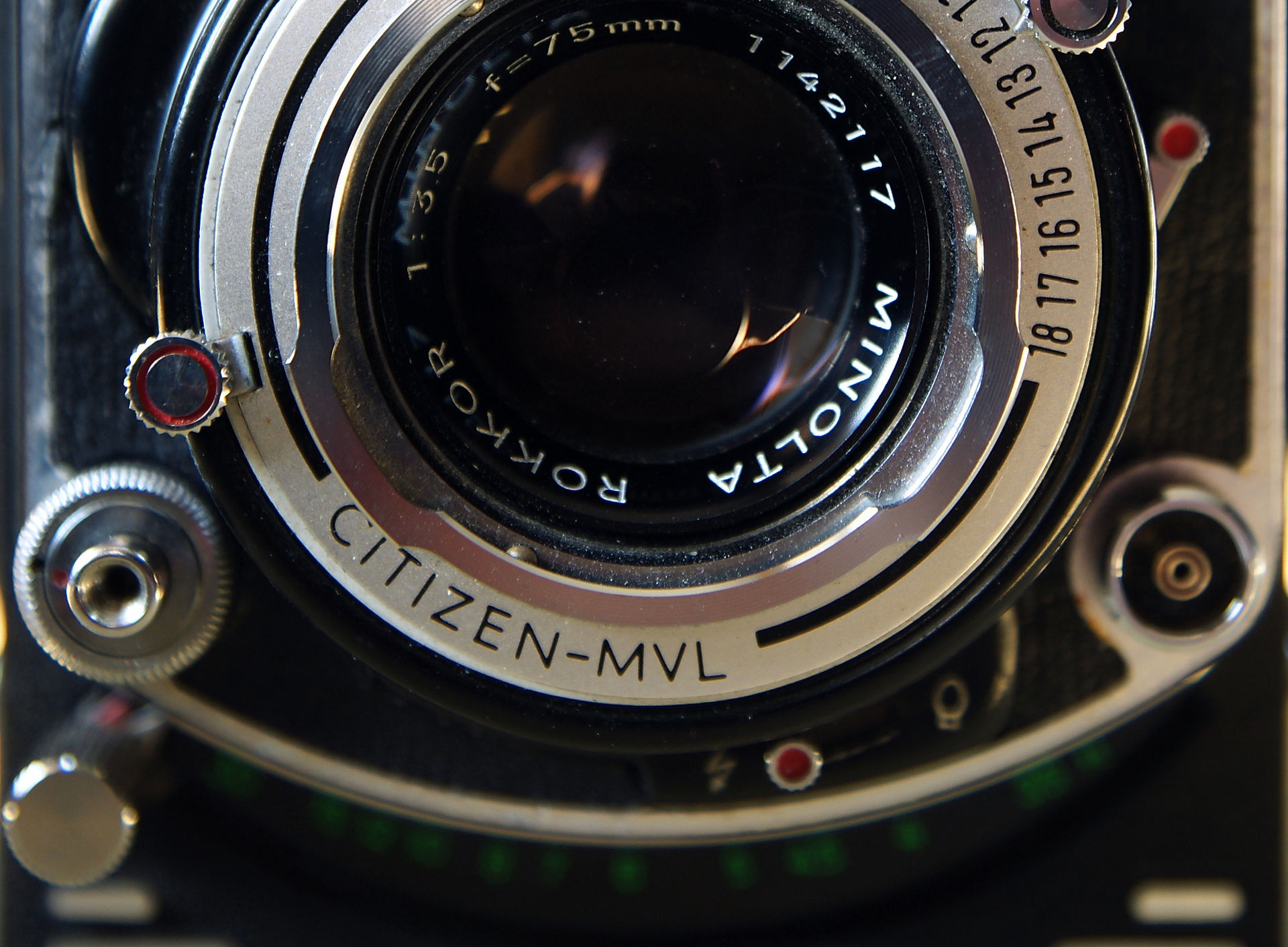
AUTOCORD : the Minolta's TLR
by Fred
TLR
The Autocord is a bi-objectives reflex camera or TLR for Twin Lenses Reflex, made by Minolta from 1955 till 1966.
Another TLR among the others? No! The Autocord is rather different from Rolleiflex, Rolleicord and other Yashica Mat.
(pictures only for illustration)
Focus
First of all, the focusing system is constituted by a bronze hélicoïd : this system is upper to those of the other bi-objectives because it is impossible to unsettle!
The focus is set by a lever situated under the objectives (and not by a button on the side of the camera, contrary to most of the other TLRs). The focus is soft and easy to realize if the extremity of the focus lever is not broken! It is a piece of Zamak and it is definitively a weak point on this camera - always think of verifying the focus lever state before buying an Autocord!
It is however about the only weak point of this camera : the global construction quality is excellent and can be compared, without blushing, with any TLR, inclusive the Rolleiflex.
Route of the film
Another interesting characteristic of the Autocord is the route of the film. Contrary to all other bi-objectives, the film is placed in the upper part of the camera and the empty reel in the bottom part. The film is bent after having been exposed and not before! The flatness of the film is thus excellent, better than in any other TLR.
Lenses
The taking lens is a Rokkor (Chiyoko or Minolta following the versions) 1:3.5 f=75mm and the viewing lens is a 1:3.2 f=75mm a little more bright. The quality of the optics is impressive, some people assert that this objective is comparable to the Planar, Xenar and even Xenotar. Actually, the difference is really difficult to establish, especially on average enlargements, but the value for money is really excellent!
Shutter
The shutter can be Optiper, Seikosha or Citizen. They are all central type with five small blades, wich allows a high speed synchronization of the flash. The earlier shutters (MXS and MXV) are limited to 1/400th sec, all other shutters go to 1/500th sec.
Flash and others
The Autocord has plethoric features: accessory shoe, flash plug, sync for magnesium bulb or electric flash (not on all models), tripod mount, trigger lock, sport finder, dubble or multiple exposure mechanism, built-in photometer on some models.
Accessories
The Autocord can also receive many accessories: sun visor and filters in bayonet 1 (bay 1), Minolta Autopole ( specific polarizing filter), Minolta Paradjuster (for the correction of the parallax), Minolta Panorama Head (to realize panoramic views).
Clic on this button for more details :
Variants
There were many variants of the Autocord; certain versions possess masks to realize 4x4 and 4x5 views, others accept the 220 film size.








standard
4x4 and 4x5 special frame counter
special 12/24 frame counter for 220 film

The last versions possess an integrated CDS lightmeter - this works with a 1,35V mercury battery, no more manufactured; alternative solutions exist : zinc-air batteries or battery carrier provided with a resistance (read the 'Tips and tricks' page).
Conclusion
To conclude, the Autocord is an excellent bi-objective reflex camera which give impressive results for a very correct price.
They are also looked for collection. Thus, the prices can vary from simple to tenfold.
Identifying your model
The model depends on a few characteristics :
1) the shutter: its name is written between the two lenses or under the taking lens.
If Optiper MXS, it's an A or A-2 or RA model (read step 3)
If Seikosha Rapid, it's a L or L-2 or L-3 model (read step 3)
If Optiper MXV, it's a MXV model
If Citizen MXV, it's a MXV-2 or RA-2 model (read step 3)
If Seikosha MX, it's an Export or L-MX model (read step 2)
If Optiper MVL, it's a RG or RG-2 model
If Citizen MVL, it's a RG-3 model or I or II or III or CDS I or CDS II or CDS III (read step 2)
2) lightmeter cell if your Autocord has one:
If Seikosha MX, it's a L-MX model
If Citizen MVL, it's a CDS model (CDS I or CDS II or CDS III) (read step 3)
3) special frame counter:
If it's a 4x4 counter with an Optiper MXS, it's a RA model
If it's a 4x4 counter with a Citizen MXV, it's a RA-2 model
If it's a 4x4 counter with a Seikosha Rapid, it's a L-2 model
If it's a ''For 24 exp push up after 12'' meter with a Seikosha Rapid, it's a L-3 model
If it's a ''For 24 exp push up after 12'' counter with an Optiper MVL, it's a RG-2.1 model
If it's a ''For 24 exp push up after 12'' counter with a Citizen MVL, it's a RG-3.1 or II or CDS II model
If it's a ''24 exp / 12 exp'' counter, it's a III or CDS III model.
For more details, see the ''Models'' page.
If you can't find it, contact me and tell me the serial number of your Autocord, the name of the shutter, if there is a lightmeter cell, if there is a special counter. Or send me a picture.
Source : http://www.collection-appareils.fr/x/html/appareil-11530-Minolta_Autocord.html
3D picture of an Autocord.
To see it in 3D you need a pair of brills equiped with one red filter and one blue filter.
